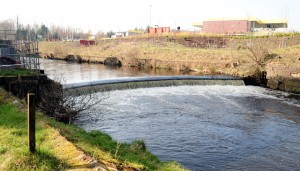The modern bridge crossing from Collier Street to Morrison’s supermarket, Johnstone, gives a scenic view of the Black Cart Water. Looking upstream, the observant shopper might notice traces of lades and paths on the Johnstone side of the river. These are the remains of Johnstone’s public washing green, dating back to the founding of the town in the 1780s. Along the riverbank run two parallel lades and various overflows, tunnels and sluices. Apart from their use by Johnstone’s residents for washing and bleaching, the lades have a bigger story.
From the early 1780s, during the development of Johnstone as a planned town, six water powered cotton mills were built, one mill each on the Floors and Peokland Burn, and four bigger mills on the Black Cart. In 1782 George Houston of Johnstone sold the old grain mill at Johnstone Bridge to Paisley textile merchant Robert Corse. On the site, Corse built the first of Johnstone’s cotton mills, the ‘Old’ mill, later known as Paton’s mill. Corse’s mansion still survives in Mansionhouse Road, Paisley, but his mill, the oldest surviving cotton mill in Scotland, burnt down in 2010.
In 1784, landowner George Houston built his own mill, Johnstone’s second cotton mill, further downstream from Corse’s mill, at the foot of Collier Street. The water power for Houston’s Laigh mill was supplied by a lade which continued from the tailrace or outflow from Corse’s mill, passing under a special arch in Johnstone Bridge. Corse also had ‘the liberty to cut a tail lade through the washing green laid off by Houston for his feuars at Johnstone’.
The water wheels in both mills were backshot, meaning the water fell on their upstream surfaces, turning them in a counter-clockwise direction. Houston’s mill had only half the fall of Corse’s wheel, and consequently half the power. Shortly after Houston’s mill was completed, Corse decided to double the size of his mill. To increase the fall of water, needed to provide the extra power for his mill extension, Corse deepened his wheel pit. Unfortunately this reduced the fall of water at Houston’s mill downstream, and thereby also reduced the power at Houston’s mill. If Houston tried to raise the water back to its original level, it flooded back into Corse’s mill, slowing his wheel.
Houston had boobed. By giving Corse the best site, with the biggest fall, he had not only compromised the power at his own mill, but damaged his pride. The problem resulted in years of legal dispute, ending up in the Court of Session in Edinburgh. George Meikle, the leading millwright in Scotland, was hired. His family were involved in numerous schemes, from designing new machinery for waulk mills and bleachfields to the deepening of the Clyde. The Meikle family were to water power what James Watt was to steam power.
George Meikle acted as arbitrator between Corse and Houston, carrying out experiments to manage the water supply between the two mills. By 1797 both mill owners agreed to adopt Meikle’s ingenious system, using one dam, two lades and various sluices, tunnels and ‘wasters’ (overflows) which would satisfy both mill owners. The whole scheme survives on plans and descriptions which are held in the national archives. Although today the site is overgrown, most of the scheme can still be seen from Morrison’s bridge. The curving dam on the Black Cart also survives.
Meikle’s solution allowed the clever management of 28 tons of water per minute to operate both mills. Just as importantly, it allowed the women of Johnstone to continue to wash and bleach their clothes by the side of the lades.
The scheme was landscaped many years ago as a small park, but more recently there have been plans to raze it. Hopefully its importance can be recognised and it can be properly recorded and preserved as part of Johnstone’s heritage.
© 2013 Stuart Nisbet (Click on image to enlarge)


